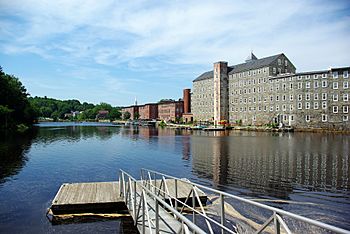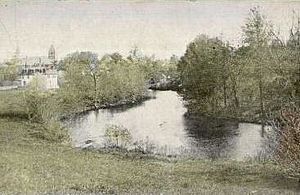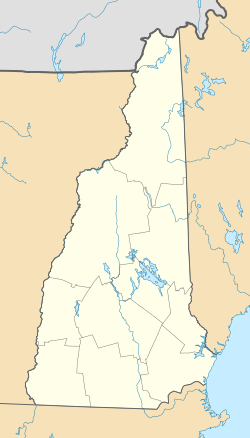Lamprey River facts for kids
Quick facts for kids Lamprey River |
|
|---|---|

Lamprey River in Newmarket, New Hampshire
|
|
| Country | United States |
| State | New Hampshire |
| District | Rockingham County |
| Municipalities | Northwood, Deerfield, Raymond, Epping, Lee, Durham, Newmarket |
| Physical characteristics | |
| Main source | Meadow Lake Northwood 594 ft (181 m) 43°12′3″N 71°12′19″W / 43.20083°N 71.20528°W |
| River mouth | Great Bay Newmarket 0 ft (0 m) 43°3′54″N 70°54′20″W / 43.06500°N 70.90556°W |
| Length | 50.2 mi (80.8 km) |
| Basin features | |
| Tributaries |
|
| Type: | Recreational |
| Designated: | November 12, 1996 |

The Lamprey River is a 50.2-mile (80.8 km) long river in southeastern New Hampshire, United States. It starts at Meadow Lake in Northwood. From there, it flows south, then generally east through several towns. These towns include Raymond, Epping, Lee, Durham, and finally Newmarket. In Newmarket, the river joins Great Bay. Great Bay is a tidal inlet of the Atlantic Ocean, connected by an estuary (where fresh and salt water mix) to the Piscataqua River. A special part of the river, from the Bunker Pond Dam in Epping to where it meets the Piscassic River, is recognized as a National Wild and Scenic River. This means it's protected for its natural beauty and importance.
Contents
Amazing Animals of the Lamprey River
The Lamprey River's shoreline, floodplains, and wetlands are home to many different kinds of animals. The river is especially important for certain fish that travel between fresh and salt water. These fish are called anadromous fish. They are born in the river, spend most of their lives in the ocean, and then return to the river to lay their eggs (spawn).
Fish Species and Their Journeys
Some of the anadromous fish that use the Lamprey River include shad, river herring, smelt, and even Atlantic salmon. These fish can swim upstream as far as Wiswall Dam in Durham. The dam stops them from going any further. The New Hampshire Fish and Game Department helps manage the river for different types of game fish. This includes brook trout, which are naturally found in the river. Other types, like rainbow trout and brown trout, are also put into the river in many places, but they are not native to this area.
Other River Creatures
You might also find Lampreys (a type of fish) in the river. However, the river actually got its name from an early settler named John Lamprey, not from the fish itself! The river is also home to many kinds of freshwater mussels.
A Look Back: History of the Lamprey River
Many parts of the Lamprey River have a rich history. In the past, it was common to find sawmills and gristmills along the river. These mills used the power of the flowing water to operate. This is called water power.
Historic Mill Sites
The Wiswall Falls Mills Site in Durham is a very important historical spot. It is even listed on the National Register of Historic Places. This site was first used as a sawmill. Later, it was used to make many different things, like knives, nuts and bolts, pitchforks, carriages, matches, and even wallpaper. Other places, like Wadleigh Falls in Lee, show what's left of old mills. These remnants tell us about the busy river culture that once existed. At one time, Wadleigh Falls had a dam that powered a mill. This mill created a large pond that was about 150 acres (61 hectares) big.
Exploring the Lamprey River's Surroundings
Along the river's edges, you can see beautiful hardwood forests and many farms. This area is growing quickly, with new neighborhoods being built. However, there is a strong local culture that loves and protects the Lamprey River.
River Activities and Events
Many local events are held on the river each year. These include fishing contests organized by towns. There is also an annual Lamprey River Canoe Race held in Epping.
As the Lamprey River travels from the Saddleback Mountains in Northwood down to Newmarket, it changes a lot. It starts as a small, fast-moving stream. Then, it becomes a larger tidal river (where the water level changes with the ocean tides). Along its path, the river has slow, winding sections and also exciting rapids. You can also find small waterfalls, like Packers Falls in Durham.



